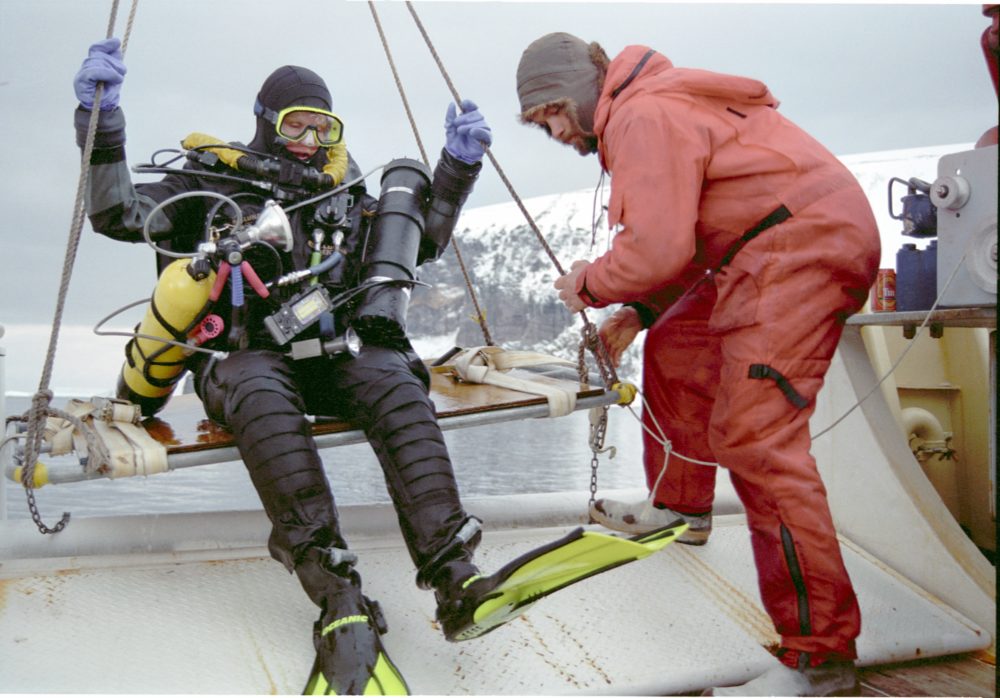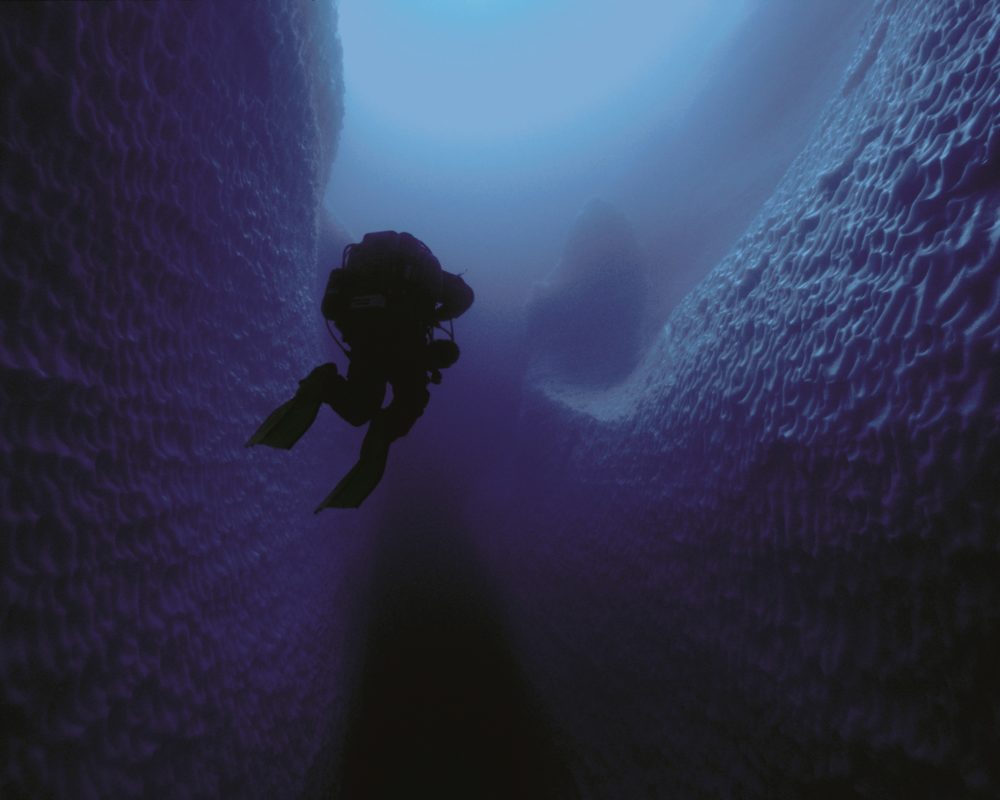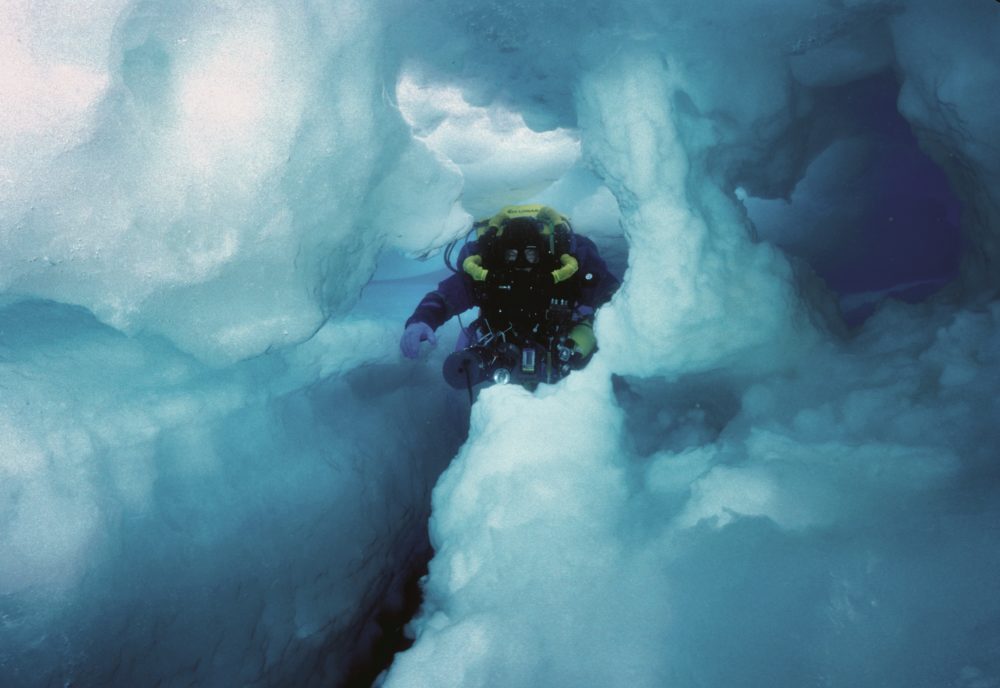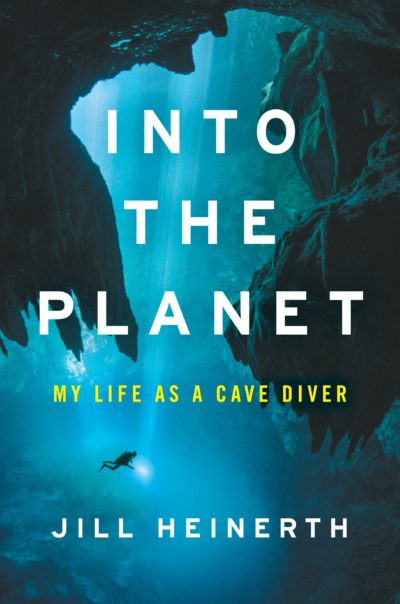Advertisement
'The Cave Tried To Keep Us': The First-Ever Dive Inside An Iceberg
Resume
This story was re-broadcast on September 12, 2020 as part of The Best Of Only A Game.
Jill Heinerth is a professional cave diving explorer and underwater filmmaker. She’s done work for PBS, National Geographic and the BBC, and she’s one of the most accomplished cave divers on the planet.
Back in 2001, accompanied by expert diver Paul Heinerth and underwater cinematographer Wes Skiles, Jill Heinerth captained an expedition to the B-15 Iceberg in Antarctica. Here's her story ... in her own words:
People look into caves, and they see nothing but darkness, terror, fear, claustrophobia. I look into a cave and I want to know what's around the next corner.
My partner and I wanted to pitch a project to go to Antarctica. We had been watching satellite photos of this great crack slowly opening up in the Ross Ice Shelf, and as we were getting close to making our pitch, the largest moving object on our planet broke away from Antarctica.
It was an iceberg the size of Jamaica. So we decided that we were going to go to Antarctica and be the first people to ever cave dive inside an iceberg.
When we pitched our project to National Geographic, they said, "Wow, there's caves inside of icebergs?" And we said, "Hell yeah, there are caves inside of icebergs!" But the truth was, we didn't know. We figured that, if this great crack had broken this piece off the ice sheet, then there had to be other cracks. It was simply a hypothesis.
The moment I saw this white pinnacle of ice for the first time, standing like a mountain on the ocean, my heart was racing. It was beautiful. It was sculptural. And I also had a feeling of reverence. This ice is endangered. And I had the sense that I was looking at something that would never be the same again. And so I felt very privileged.
The first dive, I was actually a little nervous. I wasn't nervous for myself as much as I was for Wes and for Paul, because this was their first ice dive. This was the coldest dive either of them had ever been on.
We picked this beautiful iceberg that we called "Patience Camp," and we pulled our Zodiac boat into this little bay. Wes rolled off the boat, the water started pouring into his suit, and he should have gotten out of the water immediately. He decided he wanted to shoot one minute of footage so he could see what this new camera would produce.
One minute is dangerous. I mean you very, very quickly lose the ability to manipulate your hands or operate or even think straight.
By the time he'd shot a minute of footage, he was almost incapacitated. He’s wearing, basically, a bag full of water. And we've got to get him into the boat. And it was scary. We had the first mate tugging on him and Paul and I trying to push him. And then, when we rushed him back to the Braveheart, we had to strip him down and get him into a bunk with sleeping bags to warm up, because he had already been in the water too long.

We were all very experienced cave explorers. I was familiar with all of the issues that could happen to our gear because of the ultra-cold water, the additional risks from ice diving. But what we didn't understand, really, was the environment we were going to put ourselves into in these iceberg caves.
When we decided to do our first dive inside an iceberg, it was really exciting. And I was a bit nervous. Wes and the first mate stayed in the boat, and Paul and I rolled off into slushy, chunky water.
Into The Unknown
When you first jump into the water you get an immediate "bang" — assault like an ice cream headache from the water hitting your face. And you take a few very quick deep breaths in order to knock back the cold. And, dropping your face in the water, the first thing you see is this mixing slurry of slush and melting fresh water mixed with the saltwater. And it's almost impossible to focus. And then you have to sort of push that aside, and the little chunks of ice, and then slowly descend down, dropping into this unknown.
So there was this deep vertical fissure crack. And Paul and I descended down this crevasse. And we went down and down and down into the darkness, until we suddenly came upon the sea floor. And it was about 130 feet deep — deeper than we originally thought we might want to dive in Antarctica. But there at the bottom, as I turned to my right, was a passage.
I realized we had found it. That we were in this environment that nobody had seen before.
The ice around us was blue and white and clear — sometimes like a robin's egg, sometimes like deep turquoise. But the sea floor was red and orange and yellow — every warm color — and the contrast was stunning.
And it was covered with a shag carpet of filter-feeding organisms. So there were sponges and little Christmas tree-shaped worms and things that looked like miniature palm trees sort of wafting in the current.
And then, all of a sudden, there were these isopods. They were kind of like something between a spider and a lobster, about the size of my hand. And they started raining down from cracks over my head and crawling along the floor and hitting my camera and landing on my shoulder. It was like horror story material.
"It was like horror story material."
Jill Heinerth
The sea floor has its own unique sound. It kind of reminds me of — as a kid when you'd eat that Pop Rocks candy, and you just hear the clicking, almost. And as we swam deeper and deeper into the [ice]berg, there were also strange cracks and pops and groans from the ice. It was moving, it was shifting, it was changing. And I remember at one point a very deep groaning vibration sounded. And I felt it all the way through to my toes. It was that loud.
And we kind of looked at each other and looked at our equipment, and everything seemed fine. But, when we finally turned around on that dive and worked our way back slowly to the entrance, there were big, giant pieces of ice where we had entered this cave. And the doorway we swam into was gone.
People often say, "You must be fearless." And I am not fearless. I try to do everything to prepare for risk, and I work through my head how I'm going to solve that. But you can't always predict what's going to go wrong when you're doing something that's never been done before.
And so coming back to the doorway of a cave and finding that suddenly closed is like, "Oh, my God." Every breath is currency, and I only have so many of those in my equipment. So every breath marches me either ever closer to success or ever closer to death.
'All They Could Do Was Wait'
So, as we approach these giant blocks of ice, we searched for a way around and through them and slowly, bit by bit, found a way out.
Now, we had to make a stop. We had to hang in the water about 20 feet deep before we could rise back to the surface. And that's part of just readjusting your body to the surface pressure. And when I looked up from that 20-foot stop, I saw Wes and Matt, the first mate, standing and high-fiving. Celebrating, obviously.
They told us about what it was like when that iceberg calved and that big chunk of ice sloughed off and closed the doorway and sent this great wave almost capsizing them in the Zodiac. It was terrifying for them. And the whole time, they were waiting and waiting and waiting and not knowing if we were alive or dead. They knew that there was no way to mount a rescue. And all they could do was wait.
By the next day I thought, "OK, I know more than I did yesterday. We're gonna give it another try." It's still guesswork, and it's still a risk, but I guess in that moment I felt it was a risk worth taking.
The entrance looked stable, and everything looked fine. We dropped quickly down to the bottom and went in and started photographing some of the life.

And slowly I noticed that the current was picking up. It was getting a little bit stronger and a little bit stronger. And, all of a sudden, rapidly, it was racing. And I remember sort of digging my hand into the sea floor to stop myself from rushing forward. It felt like dough. And my whole body kind of cartwheeled around my hand.
As we turned back towards the exit, we couldn't kick hard enough to move forward. And we realized the current had us. And we looked at each other and went, "Oh, boy. We're being sucked inside the iceberg."
But we could see blue light in the distance. We knew there was another exit. And, in a very quick decision, Paul and I decided to go with the flow and go towards the other doorway. But when you're inside an iceberg, you don't have a sense of how far that blue light of the doorway is from you.
And as we started to rush with the current towards that light, we kept drifting and drifting and drifting, and it didn't seem like it was getting much bigger. And we went and we went and we went until we finally reached this doorway. I thought, "OK, we're out."
And when my head broke the surface, there was ice around me. And it was higher than I could see over. And I couldn't see the boat.
"We looked at each other and went, 'Oh, boy. We're being sucked inside the iceberg.' "
Jill Heinerth
And my heart just hit my stomach. I felt like a gnat on the back of the planet. Time gets so compressed and takes on a strange nature when you're scared. When you think there's a possibility you might die and everything's out of your control. I'm not sure if it was 15 minutes or half an hour, but I was getting cold. I was shaking when, suddenly, I heard something. And what had happened is the current had knocked the boat off its anchorage just as it had flushed us through the iceberg, and they were pulling up the anchor to reset it.
And in the process of that chain being yanked up onto the boat, the boat moved, and I saw a small glimpse of the stern swing around the edge of the vertical side of the iceberg. I went, "Oh! There they are!" And I heard in the distance Wes's voice, the sweetest sound I've ever heard, say, "Is that ... Jill?"
And he spotted us on the horizon and then was slowly able to move the Braveheart towards us and get us out of the water.
'Mother Nature Had Given Us A Final Warning'
Our final dive inside Ice Island, Wes decided he was going to join us. He decided that the images that we'd brought back were so compelling that he wanted to shoot it with the best camera that we had.
We dropped down to the sea floor and moved our way inside. And, very quickly, that current picked up again. And so I turned to Wes and Paul, and I put my thumb in the signal that indicates that it's time to turn around and go.
But as we wheeled around, we realized that we might not be able to get out. And we pulled and pulled and dived our hands into the sea floor, and we weren't making our way forward. I mean, my biceps, my triceps, my forearms were shaking — pulling with every bit of energy I had to get back towards that crevasse. We just couldn't make our way forward. I was leading, Paul was behind me, and Wes was losing ground. And he yelled out, "Help me with the camera!"
And I thought "F the camera! We might die!"
I was angry. And Paul dropped back to help Wes. And I was mad at him too because I thought, "Come on you guys, you can't do this."
And they together managed to work the camera towards the entrance. But, even at the entrance, I didn't know how we were going to get up the crevasse, because this water was pouring down the crevasse. And it was so strong. It was pressing us back down every time I tried to move up.

So I looked around. I thought, "What are we going to do? How are we going to climb these walls?" It's just ice. It's slippery. I touch the wall, and it just slides down.
And then I remembered these little ice fish that we'd been studying that were about the size of my thumb. And they were living in these burrows inside the ice. And I thought, "climbing holds." I could jam a finger into that hole, and maybe I can have enough grip that I can pull my way up and get back towards the surface that was still 130 feet over our heads.
And I inched my way up, hole by hole. And Wes and Paul got there too and started to follow along, until we could get up out of the crevasse and out of the stream of current.
I remember getting back to the boat after the dive. And I was feeling quite solemn. And the science officer reached down. We were already two hours overdue, so he was relieved to see us. And I remember looking up and saying, "The cave tried to keep us today."
Mother Nature had given us a last warning.
Like good, creative people, it's never enough. You always want more. We decided we wanted to do one more dive. So we prepped our equipment, we went to have a meal and sit down and plan one more dive — a dive that we would do at the moment when the current slackened.
And as we were having a meal, we heard screams on deck. And we dropped everything, and we ran up the companionway, up onto the deck. And there was our iceberg — the cave that we had just been inside of — breaking into pieces, heaving up in the sea and sending these giant waves towards our boat. The whole square mile of ice we'd just been inside of was breaking apart and dissolving into the sea.
I was just standing there, gobsmacked on the ship's rail. I realized that if we had been in the water, we'd be dead.
When we came home and tried to tell our story, most people just thought we were insane. "How could you do that? How could you go in over and over and over again?" And, "Boy, you were lucky. You're an idiot."
But for me, it was so worth it to have that experience, to document a place that maybe no one will ever see again.
We don't know whether the B-15 iceberg was truly just simply evidence of climate change, or whether it was a part of the evolving changes in the Antarctic ice sheet. It's impossible to know.
But I do know that it was important. It was important for us to go and document that environment and everything living around it. And I'm glad to have had that experience and glad to even have had those brushes with death that made me a better, safer diver in the future.
Jill Heinerth is a professional cave diving explorer and underwater filmmaker. Her new book is called "Into the Planet."
This segment aired on September 21, 2019.
